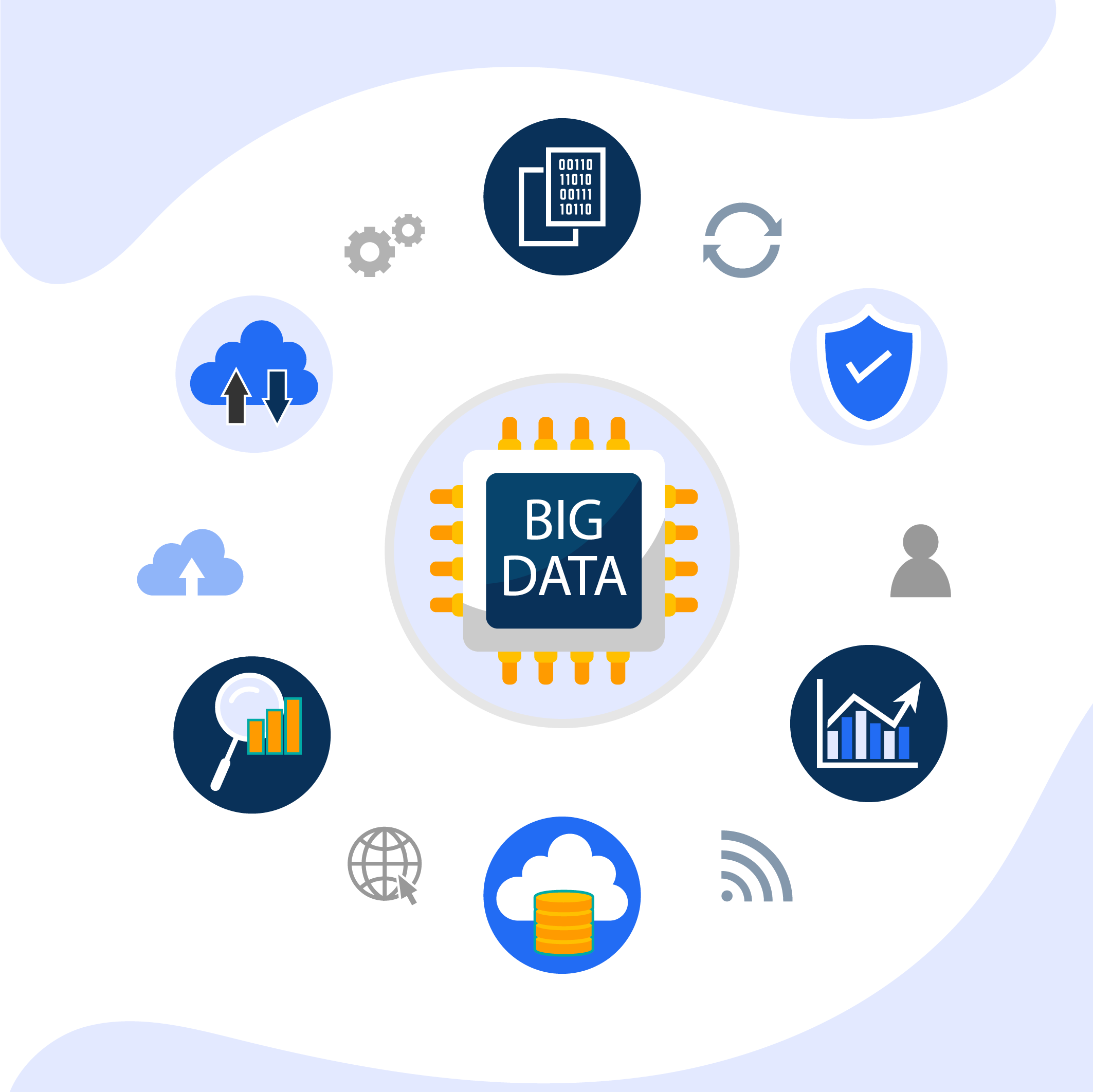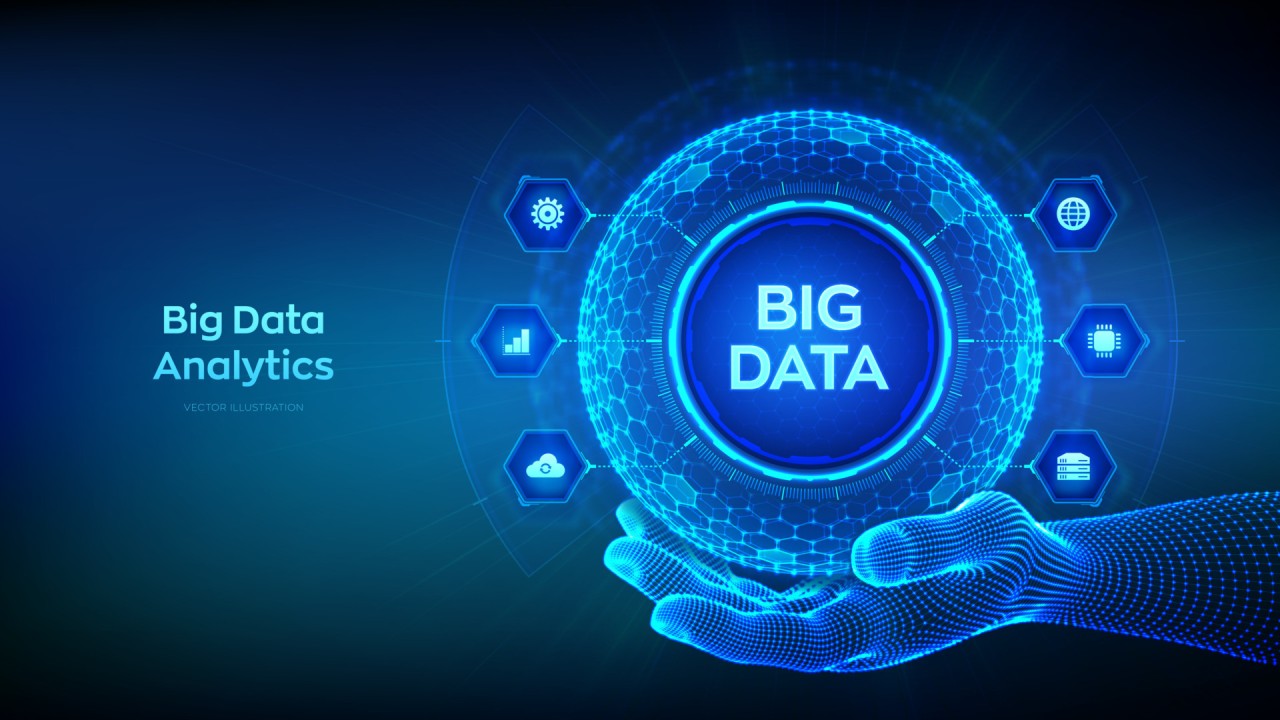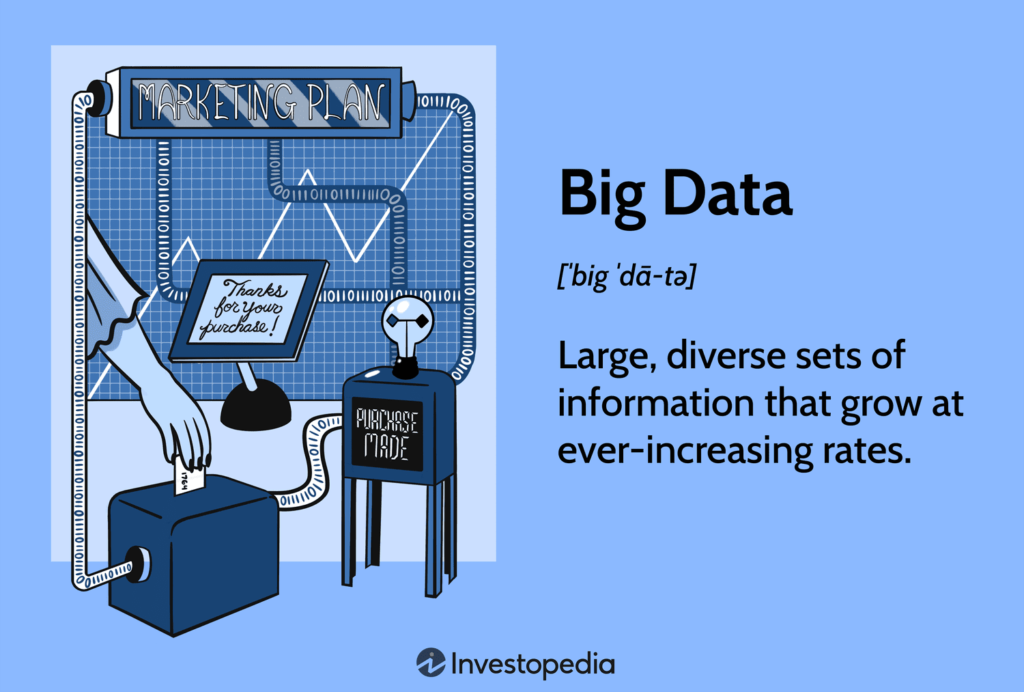Big Data refers to extremely large datasets that require advanced tools to store, analyze, and visualize. It helps businesses make informed decisions by uncovering patterns and trends.
Big Data is revolutionizing industries by enabling data-driven strategies. Companies use it to gain insights, improve efficiency, and enhance customer experiences. Advanced analytics tools process these massive datasets, providing valuable information that was previously unattainable. In healthcare, for instance, Big Data aids in predicting disease outbreaks and personalizing treatments.
Retailers utilize it to understand consumer behavior and optimize inventory. The sheer volume, velocity, and variety of Big Data present challenges, but also offer immense opportunities. By leveraging Big Data, organizations can stay competitive and innovate continually.
The Era Of Big Data
We live in the era of Big Data. The amount of data generated every second is enormous. This data holds valuable insights and power.
The Explosion Of Data
The digital age has led to a massive data explosion. Every activity online creates data. Social media, e-commerce, and sensors generate large amounts of information.
- Social Media: Each post, like, and share creates data.
- E-commerce: Every purchase and search generates data.
- Sensors: Devices and IoT contribute to data growth.
Data sources are diverse. From text, images, and videos to logs and GPS signals. This vast data needs to be collected, stored, and analyzed.
Big Data’s Role In Modern Tech
Big Data is crucial in modern technology. It drives innovations and improvements.
| Field | Impact of Big Data |
|---|---|
| Healthcare | Predictive analytics for better patient care. |
| Finance | Fraud detection and risk management. |
| Marketing | Personalized campaigns and customer insights. |
Big Data enhances machine learning and artificial intelligence. These technologies rely on large datasets to learn and improve.
Every industry benefits from Big Data. From logistics to entertainment. The possibilities are endless.

Credit: www.spiceworks.com
Core Technologies Behind Big Data
Big Data is transforming industries by unlocking insights from vast amounts of information. To harness its power, we rely on several core technologies. These technologies enable us to process, store, and analyze data efficiently.
Hadoop And Its Ecosystem
Hadoop is a powerful tool for managing large datasets. It is built to scale across many servers. It can handle petabytes of data. The Hadoop ecosystem includes tools like:
- HDFS (Hadoop Distributed File System): Stores large amounts of data across multiple machines.
- MapReduce: Processes data in parallel across a cluster of computers.
- YARN (Yet Another Resource Negotiator): Manages resources for applications running on Hadoop.
- Hive: A data warehouse system for querying and managing large datasets.
These tools work together to provide a robust framework for Big Data analytics. Hadoop is ideal for batch processing. This means it processes large volumes of data in chunks.
Real-time Processing With Apache Spark
While Hadoop is great for batch processing, Apache Spark excels at real-time data processing. Spark processes data in-memory. This makes it much faster than Hadoop.
Spark supports several key components:
- Spark Streaming: Processes real-time data streams.
- Spark SQL: Allows for SQL queries on large datasets.
- MLlib: A library for machine learning algorithms.
- GraphX: For graph processing and analytics.
Using Spark, you can analyze data as it arrives. This is crucial for applications needing instant insights. For example, fraud detection systems use Spark to detect anomalies in real-time.
Big Data Analytics In Action
Big Data Analytics is transforming industries. Companies use it to gain insights and make informed decisions. This section will explore how Big Data Analytics is applied in real-world scenarios.
Predictive Analytics
Predictive Analytics uses historical data to forecast future events. Businesses can anticipate trends and prepare accordingly. This technology is vital for staying ahead in competitive markets.
| Industry | Application |
|---|---|
| Healthcare | Predicting disease outbreaks and patient admissions. |
| Finance | Forecasting stock market trends and credit risks. |
| Retail | Anticipating product demand and stock requirements. |
Predictive Analytics helps businesses minimize risks and maximize opportunities. It is essential for strategic planning and decision-making.
Consumer Behavior Analysis
Consumer Behavior Analysis studies how customers interact with products and services. It helps businesses understand preferences and improve customer satisfaction.
- Tracking online shopping patterns.
- Analyzing social media interactions.
- Monitoring customer feedback and reviews.
By understanding consumer behavior, companies can tailor their offerings to meet customer needs. This leads to increased loyalty and higher sales.
In summary, Big Data Analytics is a powerful tool. It helps businesses predict future trends and understand consumer behavior. These insights drive growth and innovation.
Impact On Industry Verticals
The impact of Big Data on various industry verticals is profound. Industries are leveraging vast amounts of data to drive innovation and optimize operations. The healthcare and retail sectors are prime examples of how Big Data transforms industries.
Healthcare Innovations
Big Data is revolutionizing the healthcare industry. It helps in predicting outbreaks and tracking disease patterns. Healthcare providers use Big Data to improve patient care and treatment outcomes.
- Predictive Analytics: Doctors can predict patient health issues before they occur.
- Personalized Medicine: Treatments are tailored based on individual genetic data.
- Operational Efficiency: Hospitals optimize resources and reduce wait times.
Big Data also plays a key role in medical research. It accelerates the discovery of new treatments and drugs. Researchers analyze large datasets to find patterns and correlations.
Retail Revolution
In the retail sector, Big Data drives the customer experience. Retailers use data to understand buying behaviors and preferences. This leads to personalized shopping experiences.
- Customer Insights: Retailers analyze data to understand customer needs.
- Inventory Management: Data helps in predicting product demand and managing stock.
- Marketing Strategies: Personalized ads and promotions based on customer data.
Big Data also aids in fraud detection and loss prevention. Retailers analyze transaction data to identify suspicious activities. This ensures a secure shopping environment for customers.
| Industry Vertical | Big Data Impact |
|---|---|
| Healthcare | Predictive analytics, personalized medicine, operational efficiency |
| Retail | Customer insights, inventory management, marketing strategies |
Challenges And Solutions
Big Data is transforming the world. But, it comes with its own challenges. Let’s explore these challenges and the solutions to overcome them.
Data Privacy Concerns
Data privacy is crucial. People are worried about their personal information. Companies must secure this data.
Here are some key solutions:
- Encryption: Encrypt data to protect it from unauthorized access.
- Access Controls: Limit who can see the data.
- Compliance: Follow data protection laws.
- Regular Audits: Check systems regularly for vulnerabilities.
Overcoming Storage Issues
Big Data requires a lot of storage. Storing this data can be a challenge. Proper solutions can help manage storage efficiently.
Consider these solutions:
- Cloud Storage: Use cloud services to store large amounts of data.
- Data Compression: Compress data to save space.
- Tiered Storage: Use different types of storage for different data.
- Efficient Data Management: Regularly clean and organize data.
Here’s a comparison of storage solutions:
| Solution | Benefits | Challenges |
|---|---|---|
| Cloud Storage | Scalable, Accessible | Cost, Security |
| Data Compression | Saves Space, Faster Transfers | Processing Power |
| Tiered Storage | Cost-Effective, Efficient | Complexity |
| Efficient Data Management | Organized, Reduces Redundancy | Time-Consuming |

Credit: botpenguin.com
Future Trends Powered By Big Data
Big Data is revolutionizing the world. It powers new trends in technology and business. The future holds exciting possibilities. Let’s explore some of these trends.
Ai And Machine Learning
Artificial Intelligence (AI) and Machine Learning (ML) are transforming industries. They analyze vast amounts of data. This leads to better decision-making.
AI can predict future trends. It can also automate tasks. This saves time and resources. Companies can focus on innovation.
Machine Learning improves over time. The more data it processes, the smarter it gets. This leads to better accuracy and efficiency.
Here are some areas where AI and ML shine:
- Healthcare: Predicting patient outcomes and personalizing treatment.
- Finance: Detecting fraud and optimizing investments.
- Retail: Enhancing customer experience and managing inventory.
The Rise Of Edge Computing
Edge Computing processes data closer to its source. This reduces latency and increases speed. It is crucial for real-time applications.
Edge Computing supports IoT devices. These devices generate massive amounts of data. Processing this data quickly is essential. This is where Edge Computing excels.
Here are the benefits of Edge Computing:
| Benefit | Description |
|---|---|
| Speed | Data processed locally reduces delays. |
| Security | Less data sent to central servers enhances privacy. |
| Scalability | Handles data from numerous devices efficiently. |
Industries adopting Edge Computing include:
- Manufacturing: Real-time monitoring and predictive maintenance.
- Transportation: Autonomous vehicles and smart traffic management.
- Healthcare: Remote patient monitoring and emergency response.
Big Data continues to drive innovation. These trends are just the beginning. The future is bright with Big Data.
Case Studies: Success Stories
Big Data has transformed many industries. Here, we explore some success stories. These case studies highlight how Big Data revolutionizes different sectors.
Transforming E-commerce
E-commerce companies use Big Data to understand customer behavior. They analyze purchase history, browsing patterns, and customer feedback. This helps them create personalized shopping experiences.
Amazon is a prime example. They use Big Data to recommend products. Their algorithm learns from user behavior. This increases sales and customer satisfaction.
Another success story is Alibaba. They use Big Data for supply chain optimization. By analyzing data, they reduce delivery times and manage stock better. This enhances the shopping experience and boosts profits.
| Company | Use of Big Data | Outcome |
|---|---|---|
| Amazon | Product recommendations | Increased sales |
| Alibaba | Supply chain optimization | Reduced delivery times |
Revolutionizing Public Services
Big Data has a big impact on public services. Governments use it to improve city planning, health services, and transportation.
The city of Barcelona uses Big Data for smart city initiatives. Sensors collect data on traffic, waste management, and energy use. This data helps the city optimize resources and improve quality of life.
In the healthcare sector, Johns Hopkins Hospital uses Big Data to predict patient outcomes. They analyze patient records and treatment responses. This helps doctors make better decisions, improving patient care.
- Barcelona: Smart city initiatives
- Johns Hopkins Hospital: Predictive healthcare analytics

Credit: www.linkedin.com
Navigating The Big Data Landscape
The world of Big Data can be overwhelming. Understanding how to navigate this landscape is essential for success. This guide will help you choose the right tools and build a data-driven culture in your organization.
Choosing The Right Tools
Selecting the right tools for Big Data is crucial. There are many options available, each with its own benefits. Here are some popular tools:
- Hadoop: An open-source framework that allows for the distributed processing of large data sets.
- Spark: Known for its speed and ease of use, Spark can handle large-scale data processing.
- NoSQL Databases: These databases, like MongoDB and Cassandra, are designed for large-scale data storage and retrieval.
- Data Visualization Tools: Tools like Tableau and Power BI help in visualizing data for better insights.
Each tool has unique features that cater to different needs. Choosing the right one depends on your specific requirements. Consider factors like data size, processing speed, and ease of use.
Building A Data-driven Culture
Creating a data-driven culture is essential for leveraging Big Data effectively. Here are some steps to build this culture:
- Educate Your Team: Ensure everyone understands the value of data. Provide training and resources.
- Encourage Data-based Decisions: Promote the use of data in decision-making processes. Reward data-driven choices.
- Invest in Data Skills: Hire or train employees with strong data analysis skills. This includes data scientists and analysts.
- Foster Collaboration: Encourage different departments to work together. Share data insights across teams.
- Utilize Data Tools: Provide access to the right tools and technologies. This helps in making data accessible and actionable.
Building a data-driven culture takes time and effort. It’s a continuous process that involves education, collaboration, and investment.
Frequently Asked Questions
What Is An Example Of Big Data?
An example of big data is social media analytics. Platforms like Facebook and Twitter generate vast amounts of user data daily.
What Best Defines Big Data?
Big data refers to extremely large datasets that require advanced tools to analyze and extract insights. It includes volume, velocity, variety, and veracity. Businesses use big data to uncover trends, patterns, and correlations for better decision-making.
What Is Big Data Mainly For?
Big data is mainly for analyzing large, complex datasets. It helps businesses gain insights, improve decision-making, and boost efficiency.
What Are The Five 5 Of Big Data?
The five V’s of big data are Volume, Velocity, Variety, Veracity, and Value. Volume refers to data size. Velocity is the speed of data processing. Variety means different data types. Veracity indicates data accuracy. Value represents data’s usefulness.
Conclusion
Big Data is transforming industries by providing valuable insights and improving decision-making processes. Embrace its potential to stay competitive and innovative. Businesses leveraging Big Data can unlock new opportunities and drive growth. Stay informed and adapt to harness the full power of Big Data in your organization.

